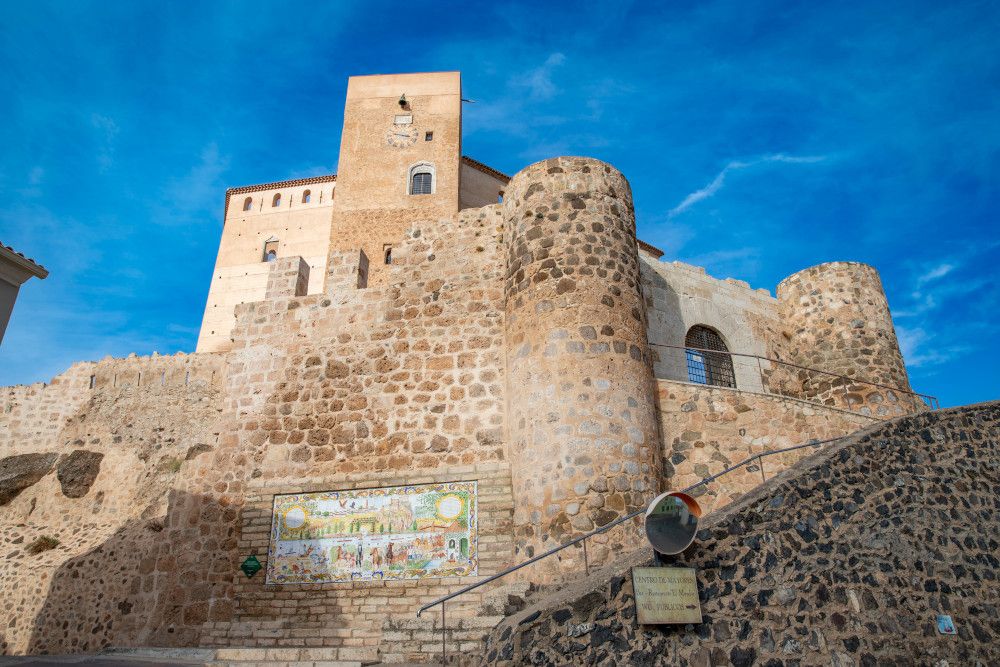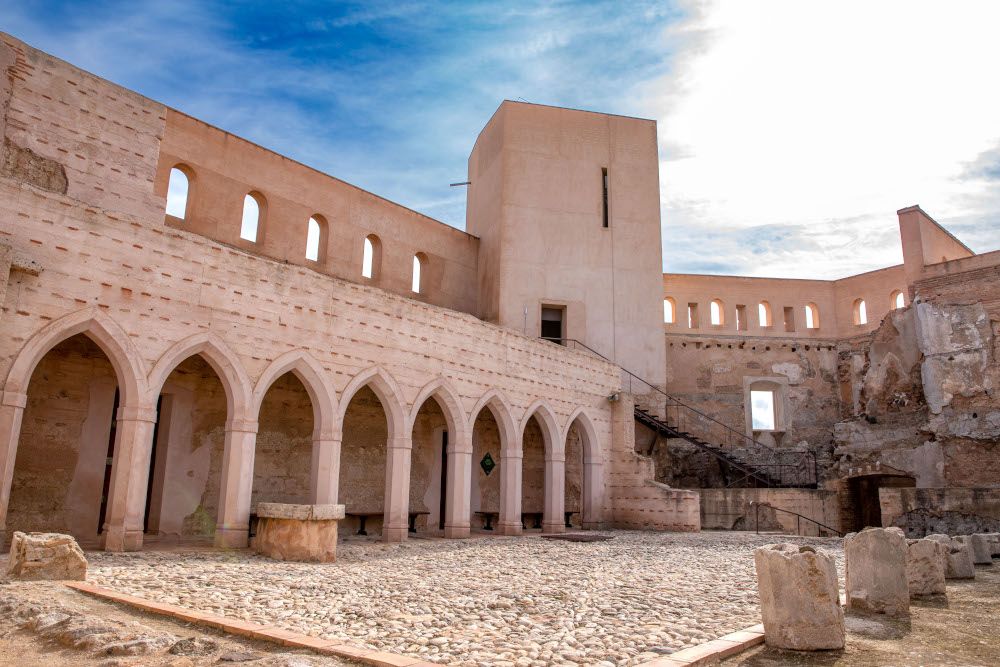Cofrentes
Cofrentes is located 103 km southwest of Valencia on the N-330 (Requena-Almansa) road, at the confluence of the rivers Júcar and Cabriel. It covers an area of 103.18 sq km and is located at an altitude of 430 m. above sea level. It has 978 inhabitants (source: INE 2007). The River Cabriel enters the municipality from Requena in a north-south direction, crossing between the hamlets of Basta and Alcance. Near Cofrentes, it turns east and flows into the River Júcar. The river enters the municipality from the nearby municipality of Jalance, following an extremely winding route in a south-north direction. Following its confluence with the River Cabriel, it continues eastward and passes through the municipality of Cortes de Pallás.
The town is of Roman origin, and it was the Romans who give its original name of Confluentum, without doubt due to its location at the confluence of the rivers Júcar and Cabriel.
Gastronomy:
“Gazpachos”
The most typical way to serve this regional dish is straight from the casserole, as was the custom in the past of the local shepherds. This tradition is still observed today by men working in the mountains.
First, the meat is chopped and boiled. When it is well-cooked, it is removed from the flame. A “sofrito” sauce, made with garlic and tomato, is added to the stock. Mountain mushrooms, or ‘pebrazos’, are added to give it a special touch. While the meat is cooking, we prepare the cake. Flour is placed in a pyramid on a table. Make a hole in the middle and add a little salt with very hot water. The dough is rolled with a roller until we have a round, very thin mass, which is cooked in a very hot oven.
“Zurracapote”
The most typical drink made in Cofrentes is “zurracapote”. It is made with must, eau de vie, sugar, cinnamon and coffee, although each family has its own recipe. This is a good drink for keeping warm.
Peach
If there is an outstanding fruit in Cofrentes, it is the peach. It belongings to the Cofrentes variant of “Carrasco”, and is picked in September. It is characterized by its large size and its pleasant taste.
“Orza” cured sausage
This is a typical dish from the inland areas, corresponding to the period in which pigs are slaughtered for their meat. Its name derives from the lack of refrigeration systems for the storage of food in the past. Cured sausages (“longanizas”, “morcilla”, “chorizo”, etc.) were fried, along with pork ribs and loin, and then placed in recipients called “orzas” with oil in order to conserve the meat. “Orzas” are still used today, although it is more common to use glass jars. It is usually accompanied with garlic and potatoes. This companion dish is simple to prepare, although it takes a little time. Dried garlic is crushed in a mortar, egg yolk is added and the mixture is stirred whilst slowly adding oil. Once it has thickened, we add boiled potatoes. The custom is to eat it while dipping bread.
“Torta mal hecha”
Confectionery products are very present in Cofrentes’ cuisine. The most popular sweet products are sweet potato cakes, pumpkin donuts and “torta mal hecha”. The latter is the most typical of all. In order to prepare it, we must first whisk eggs, lemon zest and sachets of leavener in a bowl. When the mass is consistent, oil is added and it is beaten again. Milk is then added and we continue beating. Lastly, we add the flour and beat once again to avoid the formation of any lumps. The semi-liquid mass is placed in a baking tray that has previously been covered with thin paper. Place in the oven for 20-20 minutes. Sufficient time for it to brown. It is then sprinkled with abundant sugar.
Places of interest:
Cofrentes Castle
The castle is located 394 m. above sea level in the highest part of Cofrentes, 95 m. above the bed of the River Cabriel. It has a rectangular layout, flanked by two adjacent towers and eight masonry towers. There were originally various floors, the rooms of which were decorated with Gothic plasterwork.
It is divided into three parts:
- Lower area or “Albacar”
- Main or middle area.
- Upper area or Bastion.
Mention may also be made of the Keep, of which four levels survive, the first of which is only accessible from the Upper Level. There remain vestiges of its late Gothic and Renaissance decor. The tower houses a recently-restored clock.
Cofrentes Tourist Info organizes daily guided visits to the castle between 11.00h and 17.00h. Visits can be booked by calling 96 189 43 16.
“Cerro de Agras” Volcano
The volcano measures 527 meters in height and has extraordinary scientific and educational value. It is considered the only recent volcanic site in the Valencia Region. The most visible characteristic of “El Cerro de Agras” is the expulsion of CO2 (carbon dioxide) and CH4 (methanol) through a magma chamber located in the hill’s depths. The chamber emits gas bubbles that eventually enter the Hervideros spring. It is here that we find the Hervideros Spa, so named due to the manner in which the water springs from the earth, almost as if it were boiling.
To reach the volcano, take the N-330 road in the direction of Requena. Once you have crossed the modernist bridge, go around “El Cerro de Agras”, take the first turn left and follow the road leading to the summit of “El Cerro de Agras”.
Tower Clock (Castle)
The Tower Clock, which has been restored, is located in the castle’s keep. According to experts, the Cofrentes clock is the oldest in the Valencia Region. In the past, the “cofrentinos” could tell the time by listening to the knolls of the bell, which marked the hours and the half hours. The conception of the clock belongs to a period in the history of watchmaking known as “pre-pendular”, that is to say, it is older than the invention and adoption of clock pendulums by Galileo and Huyguens. It is an ingenious invention that was built before the mid-17th century. The clock was located in the Keep, which offered sufficient height for the weights to drop and allowed the ringing of the bell to be heard throughout the town.
“Embarcaderos”
The dam is located on the Embarcaderos reservoir, to which it owes its name. It is one of the most frequented locations in the municipality by those keen on fishing. The following species can fished in the area: black-bass, pike and bleak, among others. The view of the reservoir and its surroundings is spectacular as it allows the visitor to observe the two rivers, the Júcar and the Cabriel, that flow around the town. The sources of these rivers are to be found in “los Montes Universales”. The reservoir is part of the tail-end of the “Cortes” Reservoir, located in the neighbouring municipality of Cortes de Pallás. The reservoir has a capacity of 11,000,000 million cubic metres, making it one of the smaller reservoirs in the Valencia Region. To reach Embarcaderos, we take the N-330 towards Requena and, after crossing the bridge over the River Cabriel, take the paved road on the right to our destination.
River Júcar Route
Cofrentes has the first tourist river route to have been created in the Valencia Region. It is a spectacular and relaxing route along the stretch of River Júcar that lies between Cofrentes and Cortes de Pallás. A boat with capacity for fifty passengers takes a little over an hour to travel the 14 km of the Cortes Reservoir, which lies between the village of Cortes de Pallás and Cofrentes. The river route allows passengers to contemplate places of great beauty and environmental value, including the rugged mountains that are part of the impressive “Muela de Cortes” range, which lie 400 m above the level of the River Júcar.
Festivities:
Saint Anthony Abad
These festivities are held in mid-January. Of all the events, the night of ‘Los Sagatos’ is the most important and the most anticipated by the “cofrentinos”. The locals gather for dinner around bonfires to warm themselves in the cold night and enjoy the atmosphere with friends and family. The inhabitants enjoy Cofrentes’ most typical drink, “zurracapote”, made with must obtain from harvested grapes. It is a sweet, strong liqueur.
The festivities include emotional religious acts, such as the processions dedicated to the patron of Cofrentes, Saint Anthony Abad. On 17th January, the main day of the festivities, the neighbours church attend with their pets which, upon the conclusion of the mass, are blessed by the priest at the church door. This is when the ‘mayordomas’, who are responsible for organizing the festivities, hand out blessed bread.
Other events held during the festivities include competitions, shows, firework displays, street dances, open-air lunches and the singing of traditional “coplillas” in honour of Our Lady of Sorrows.
May Festivities
Held in early May in honour of St. Joseph the Worker. One of the most important religious events is the song offered to ‘Los Mayos de Cofrentes’, which is sung by “la Rondalla” and the choir. The event is held in the church that bears the saint’s name. After the Mass, mothers celebrate a floral offering to the Virgin, during which they pray for their children and blessed bread is distributed.
The highlight of these festivities is the representation of lumber being brought down the River Cabriel, known as the ‘Maderada’. This trade brought fame to the people of Cofrentes for centuries, and for this reason they are known as “madereros”.
A custom, which has become a tradition of this festivity, is the preparation of a giant paella, around which all the inhabitants of Cofrentes, as well at the town’s visitors, gather. As during all the town’s festivities, different activities such as sports, culinary and cultural competitions are organized. The cultural activities in particular are organized in order to keep the town’s popular folklore alive.
August Festivities
Held on the 15th August in honour of Our Lady of the Assumption. They can be considered the town’s most important festivities. A variety of events and activities are held during these days to meet the preferences of all the “cofrentinos” and visitors of all ages. Amid great expectation, the Queen of the Festivities and her Court of Honour are chosen. The town’s streets are decorated for the occasion. The religious acts are also important. One of the most traditional involves the carrying of a statue of Our Lady of Solitude in procession from the Calvary, that is, from the Hermitage of Our Lady of Solitude, to the Church of St. Joseph the Worker. In a more recreational atmosphere, the parade is held, together with a float parade-contest. The events are completed with street dances, concerts, shows, a medieval market or sports activities.





